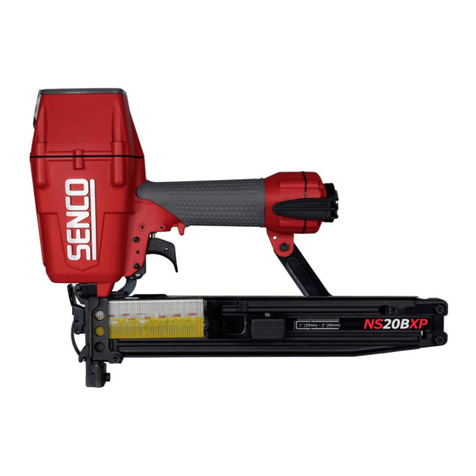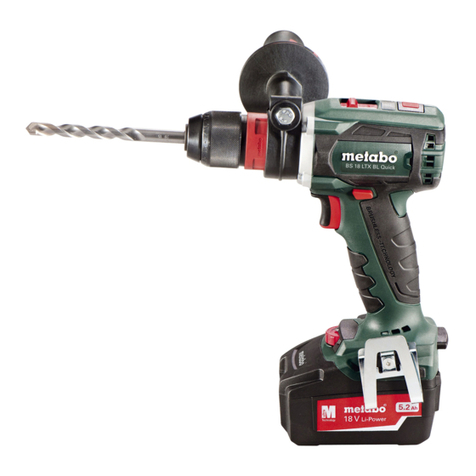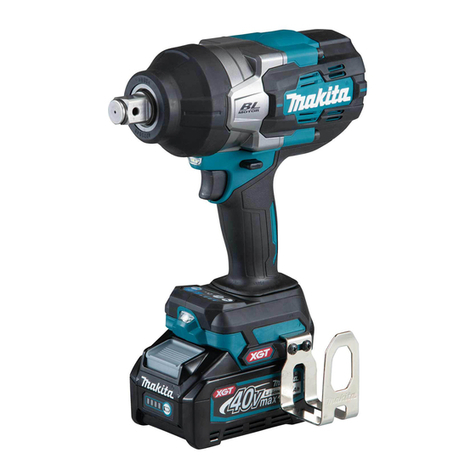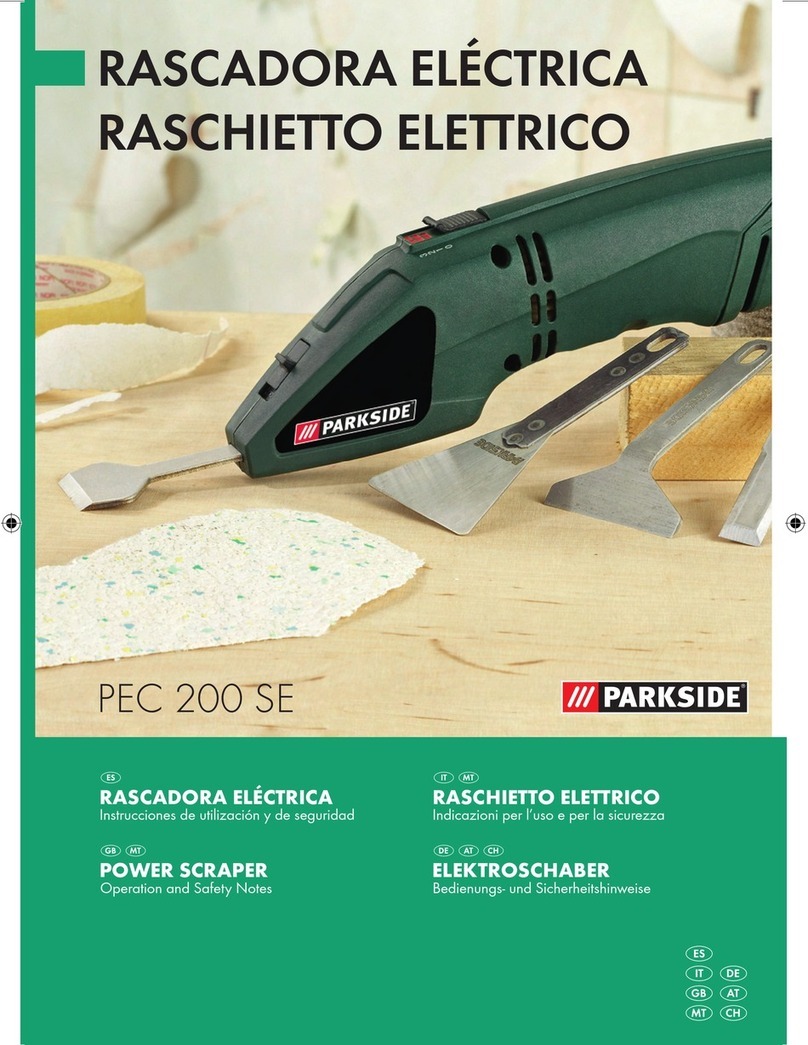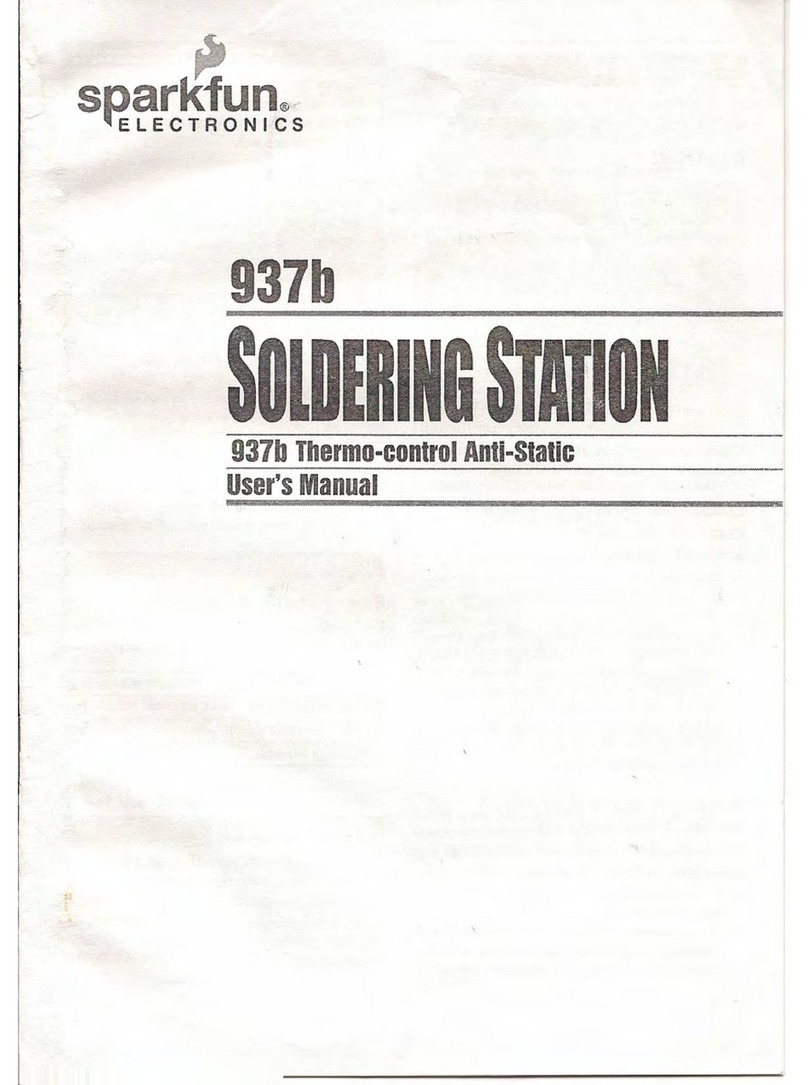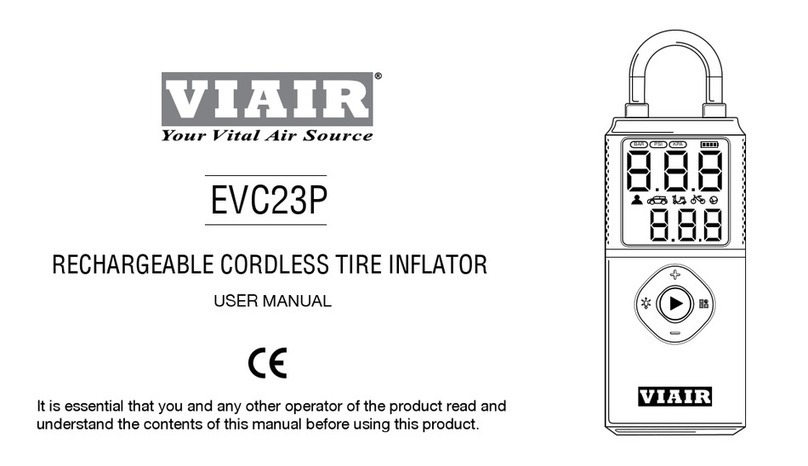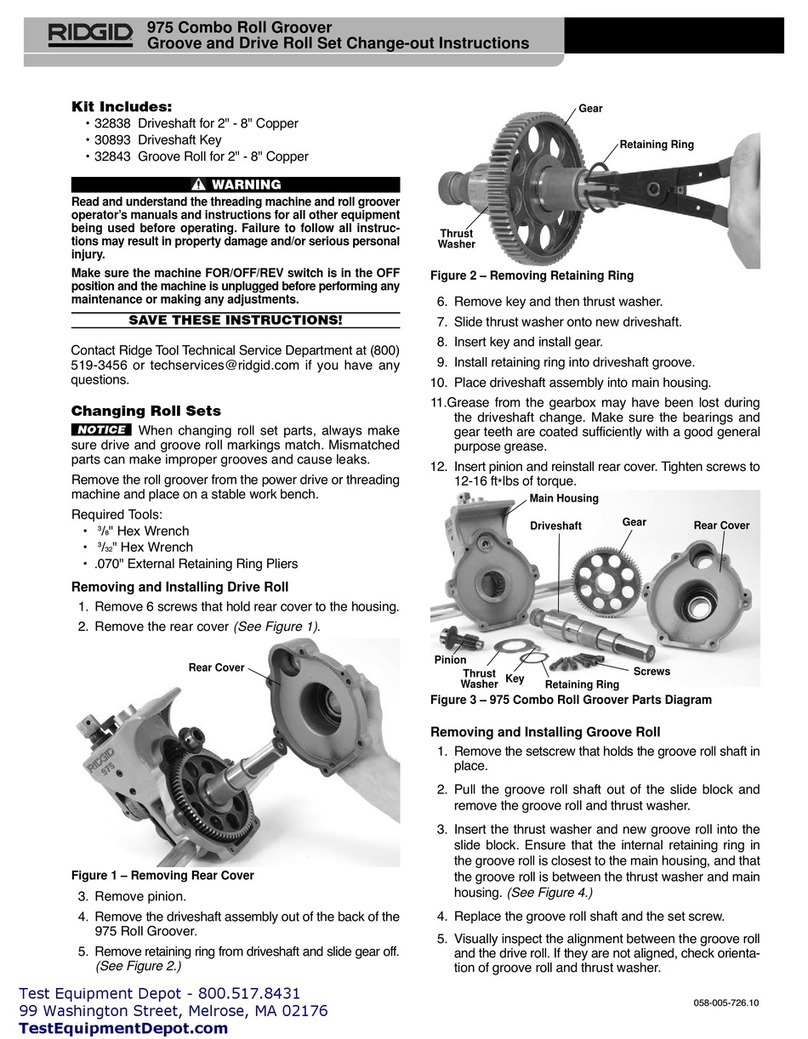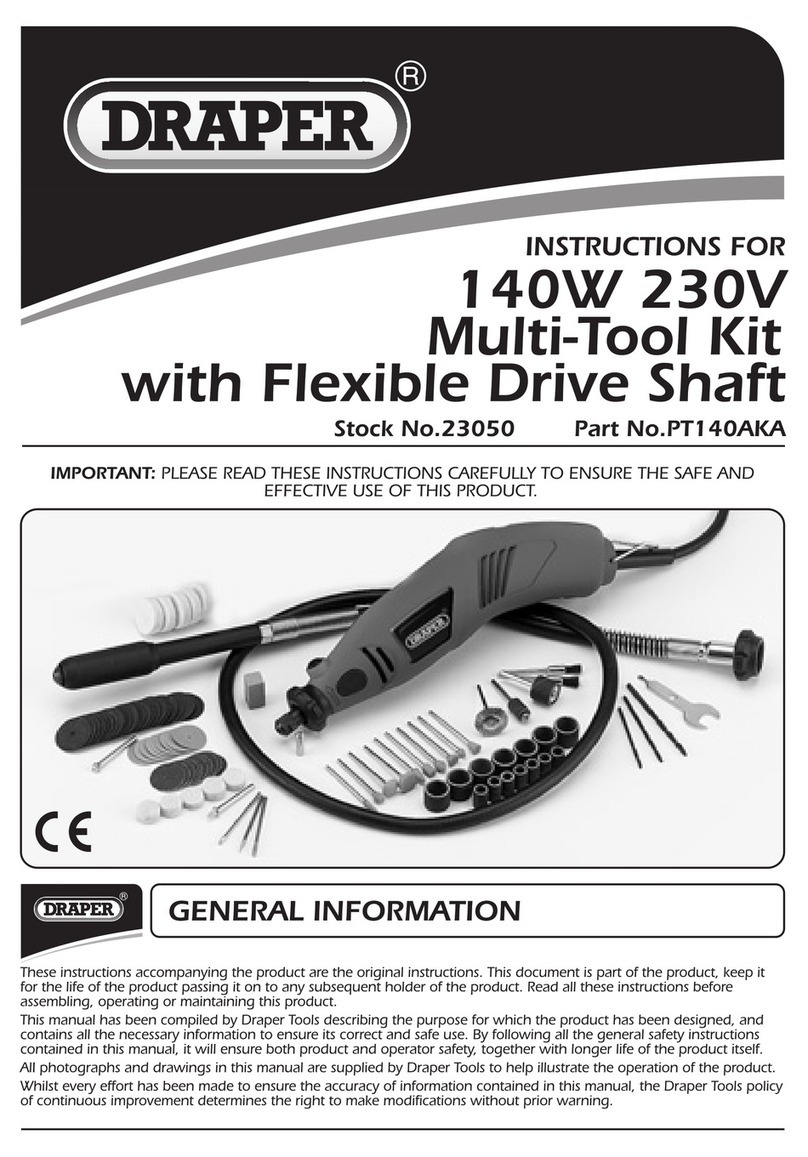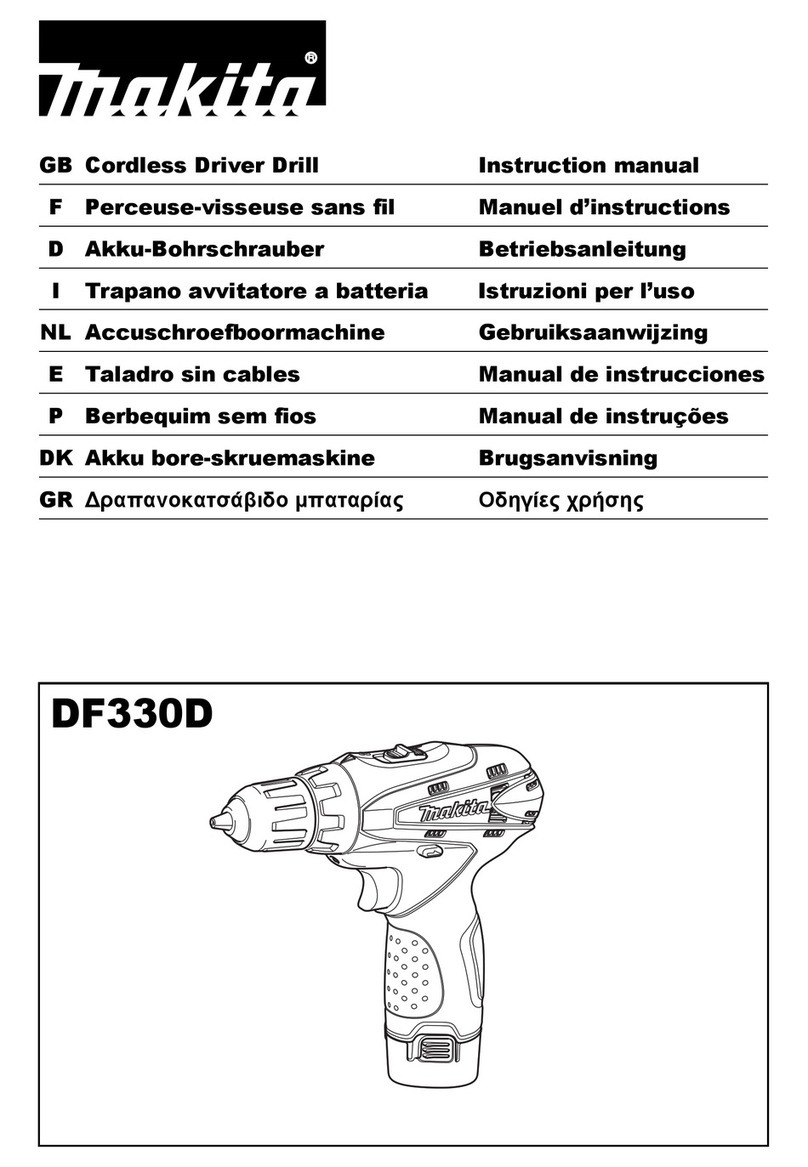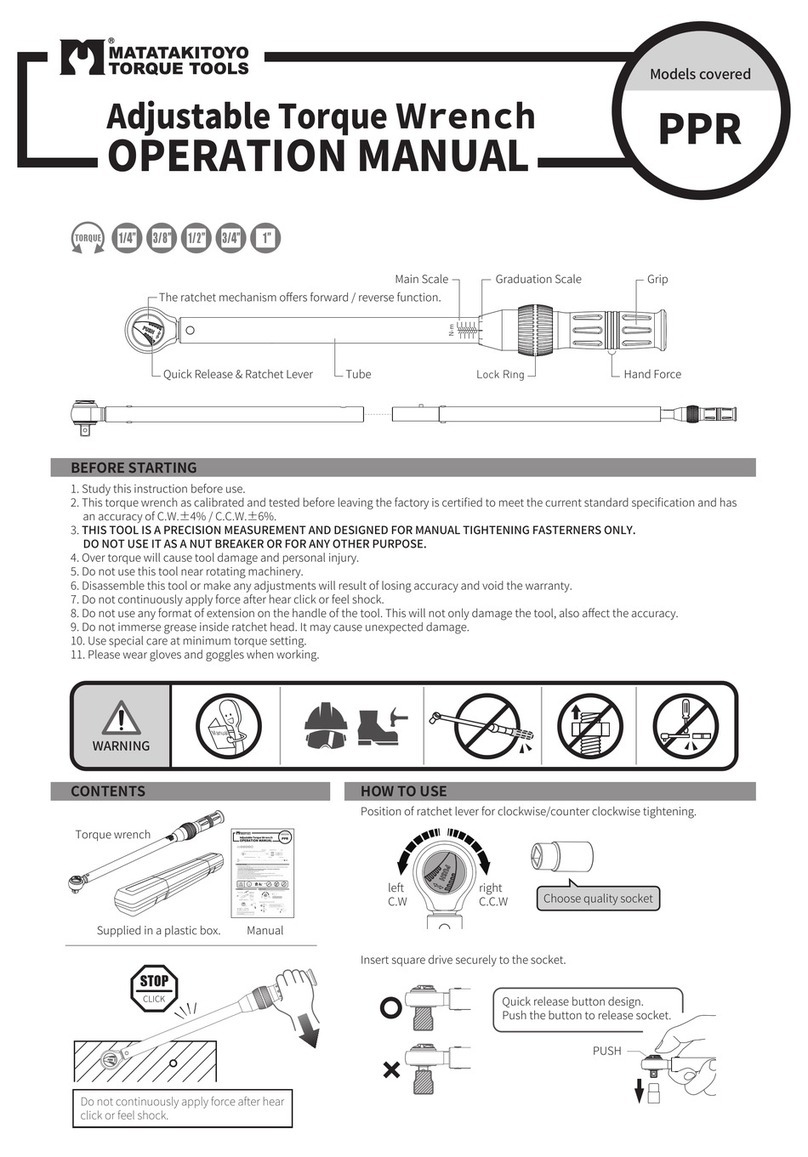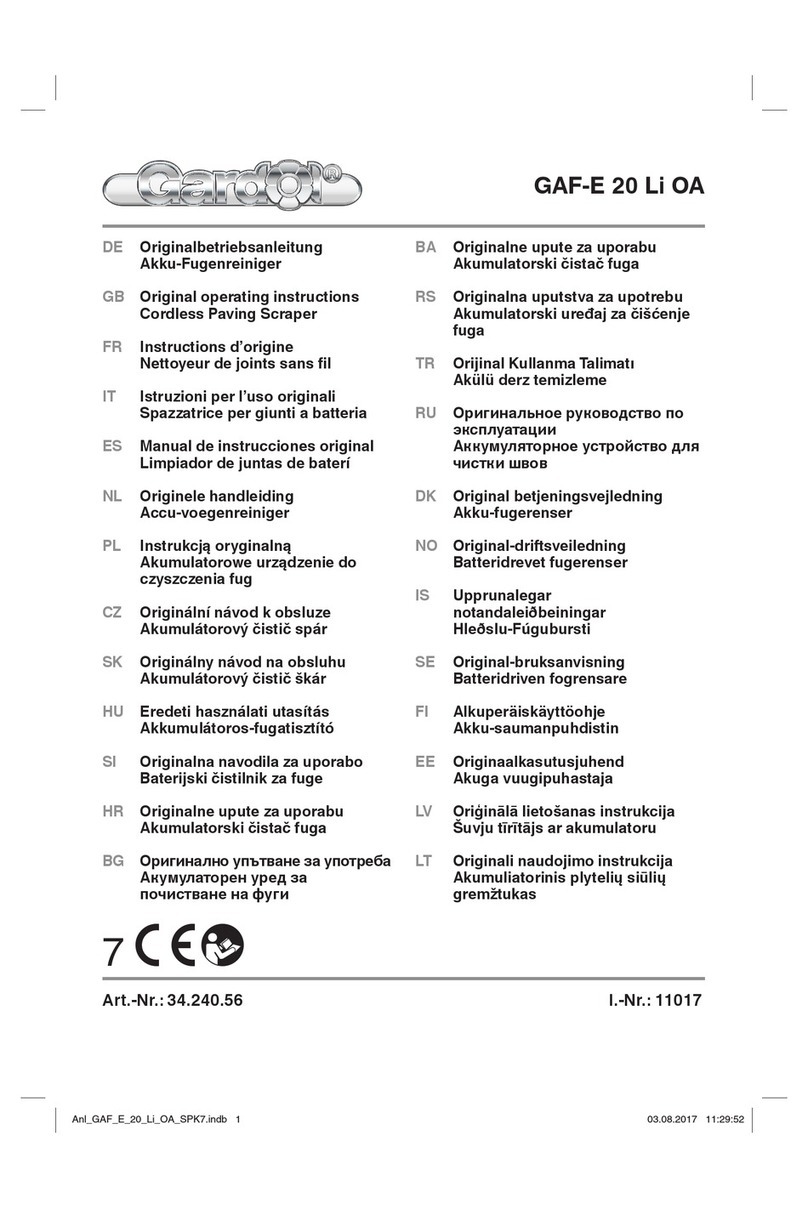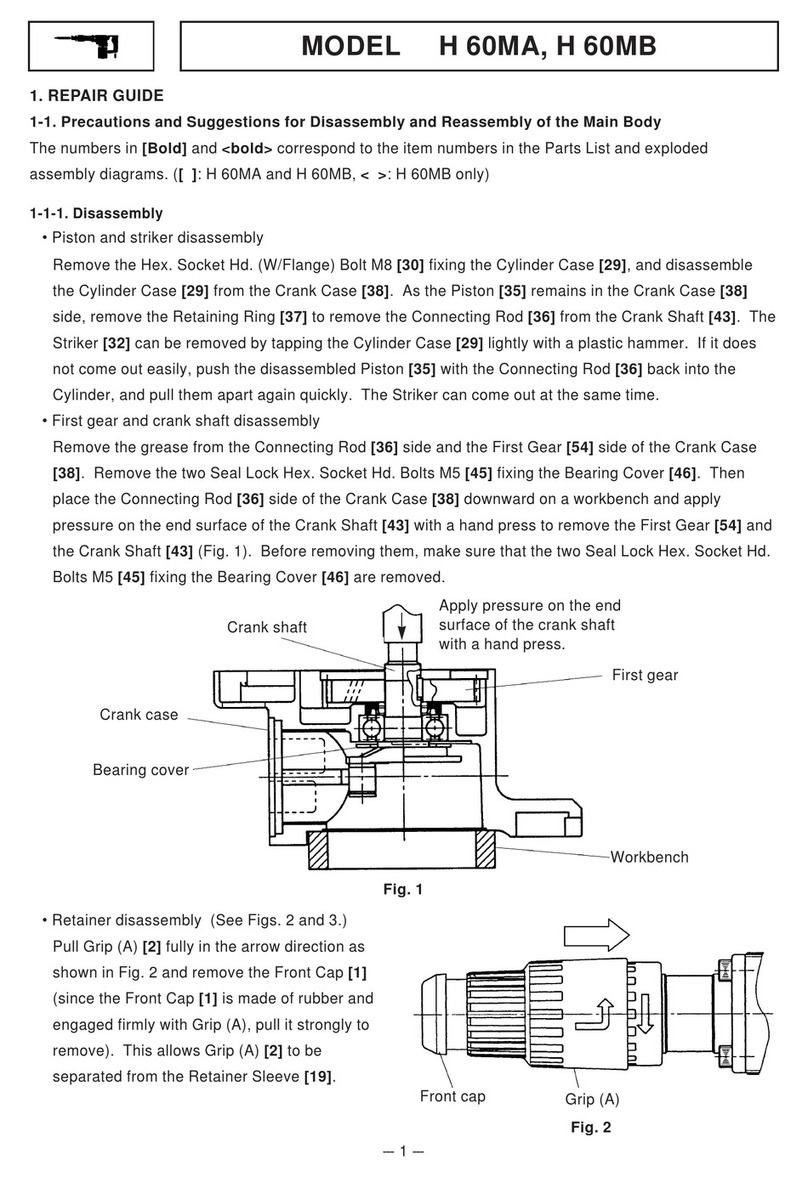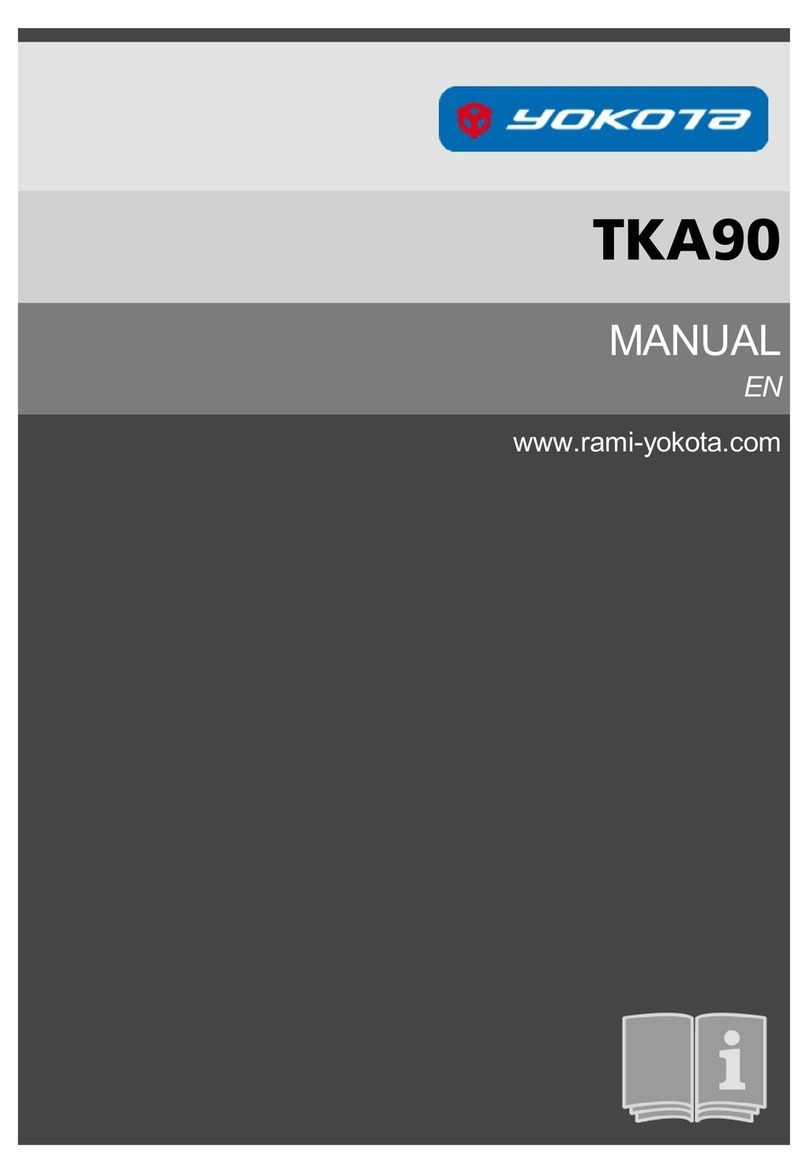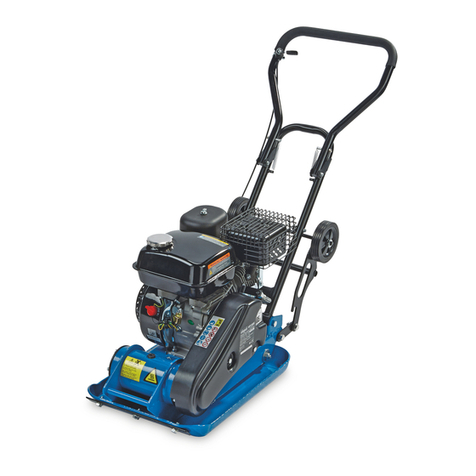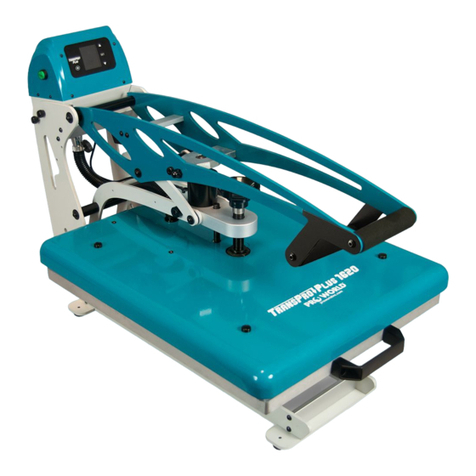skill 3385 Assembly instructions

SM 2610957105 05-08 5/6/08 3:00 PM Page 1
Skil 3385
Atenção! Leia antes de usar.
¡Atención! Lea antes de usar.
Attention! Read before using.
Operating/Safety Instructions
Instruções de Operação e Segurança
Instrucciones de funcionamiento
y seguridad

2.
General Safety Rules
Work Area
KEEP CHILDREN AWAY
Do not let visitors contact tool or extension cord. All
visitors should be kept safe distance from work area.
KEEP WORK AREAS CLEAN
Cluttered areas and benches invite accidents.
MAKE WORKSHOP KID-PROOF
With padlocks, master switches, or by removing
starter keys.
AVOID DANGEROUS ENVIRONMENTS
Don’t use power tools in damp or wet locations. Keep
work area well lit. Do not expose power tools to rain.
Do not use the tool in the presence of flammable
liquids or gases.
Personal Safety
KNOW YOUR POWER TOOL
Read and understand the owner’s manual and labels
affixed to the tool. Learn its application and
limitations as well as the specific potential hazards
peculiar to this tool.
DON’T OVERREACH
Keep proper footing and balance at all times.
STAY ALERT
Watch what you are doing. Use common sense. Do
not operate tool when you are tired. Do not operate
while under medication or while using alcohol or
other drugs.
WEAR PROPER APPAREL
Do not wear lose clothing, gloves, neckties, rings,
bracelets, or other jewelry which may get caught in
moving parts. Nonslip footwear is recommended.
Wear protective hair covering to contain long hair.
ALWAYS USE SAFETY GLASSES
Also use face or dust mask if cutting operation is dusty,
and ear plugs during extended periods of operation.
Everyday eyeglasses have only impact resistant
lenses, they are NOT safety glasses.
GUARD AGAINST ELECTRIC SHOCK
Prevent body contact with grounded surfaces. For
example: pipes, radiators, ranges, refrigerator
enclosures.
DISCONNECT TOOLS FROM POWER SOURCE
When not in use, before servicing, when changing
blades, bits, cutters, etc.
KEEP GUARDS IN PLACE
In working order, and in proper adjustment and
alignment.
REMOVE ADJUSTING KEYS AND WRENCHES
When not in use, before servicing, when changing
blades, bits, cutters, etc.
REDUCE THE RISK OF UNINTENTIONAL STARTING
Make sure the switch is in the “OFF” position before
plugging in tool.
GROUND ALL TOOLS
This tool is equipped with an approved 3-conductor
cord and a 3 prong grounding type plug to fit the
proper grounding type receptacle. The green
conductor in the cord is the grounding wire. Never
connect the green wire to a live terminal.
NEVER STAND ON TOOL OR ITS STAND
Serious injury could occur if the tool is tipped or if the
cutting tool is accidentally contacted. Do not store
materials on or near the tool such that it is necessary
to stand on the tool or its stand to reach them.
CHECK DAMAGED PARTS
Before further use of the tool, a guard or other part
that is damaged should be carefully checked to
ensure that it will operate properly and perform its
intended function. Check for alignment of moving
parts, mounting, and any other conditions that may
affect its operation. A guard or other part that is
damaged should be properly replaced.
All repairs, electrical or mechanical,
should be attempted only by trained
repairmen. Contact the nearest Skil Factory Service
Center, Authorized Service Station or other
competent repair service.
Use only Skil replacement parts; any
others may create a hazard.
The use of any other accessories not
specified in the current Skil catalog,
may create a hazard.
“SAVE THESE INSTRUCTIONS”
“READ ALL INSTRUCTIONS” Failure to follow the safety rules listed below and other basic safety
precautions may result in serious personal injury.
WARNING
!
WARNING
!
WARNING
!
WARNING
!
SM 2610957105 05-08 5/6/08 3:00 PM Page 2

3.
Additional Safety Rules
Tool Use
DON’T FORCE TOOL
It will do the job better and safer at the rate for which
it was designed.
USE THE RIGHT TOOL
Don’t force a small tool or attachment to do the job of
a heavy duty tool. Don’t used tool for purpose not
intended—for example, don’t use a circular saw for
cutting tree limbs or logs.
SECURE WORK
Use clamps or a vise to hold work. It’s safer than
using your hand and it frees both hands to operate
the tool.
NEVER LEAVE TOOL RUNNING UNATTENDED
Turn power off. Don’t leave tool until it comes to a
complete stop.
Tool Care
DO NOT ALTER OR MISUSE TOOL
These tools are precision built. Any alteration or
modification not specified is misuse and may result in
dangerous conditions.
AVOID GASEOUS AREAS
Do not operate electric tools in a gaseous or
explosive atmosphere. Motors in these tools normally
spark, and may result in a dangerous condition.
MAINTAIN TOOLS WITH CARE
Keep tools sharp and clean for best and safest
performance. Follow instructions for lubricating and
changing accessories. Inspect tool cords periodically
and if damaged, have repaired by authorized service
facility. Inspect extension cords periodically and
replace if damaged. Keep handles dry, clean and
free from oil and grease.
Before connecting the tool to a power source
(receptacle, outlet, etc.), be sure voltage supplied is
the same as that specified on the nameplate of the
tool. A power source with a voltage greater than that
specified for the tool can result in serious injury to the
user, as well as damage to the tool. If in doubt, DO
NOT PLUG IN THE TOOL. Using a power source with
a voltage less than the nameplate rating is harmful to
the motor
.
THINK SAFETY
SAFETY IS A COMBINATION OF
OPERATOR COMMON SENSE AND ALERTNESS AT
ALL TIMES WHEN THE BAND SAW IS BEING USED.
Do not allow familiarity (gained from frequent use of your
band saw) to become commonplace. Always remember
that a careless fraction of a second is sufficient to inflict
severe injury.
Some dust created by power
sanding, sawing, grinding, drilling,
and other construction activities contains
chemicals known to cause cancer, birth defects or
other reproductive harm. Some examples of these
chemicals are:
•Lead from lead-based paints,
•Crystalline silica from bricks and cement and other
masonry products, and
•Arsenic and chromium from chemically treated
lumber.
Your risk from these exposures varies, depending on
how often you do this type of work. To reduce your
exposure to these chemicals: work in a well ventilated
area, and work with approved safety equipment, such
as those dust masks that are specially designed to filter
out microscopic particles.
NOTE AND FOLLOW THE SAFETY WARNINGS
AND INSTRUCTIONS THAT APPEAR ON THE
BAND SAW PRESS:
WARNING
!
WARNING
!
SM 2610957105 05-08 5/6/08 3:00 PM Page 3
Read all safety warnings and all instructions.
Wear safety goggles.

To reduce the risk of injury:
1. Do not stare directly at the laser beam. Eye damage
mayoccur if you deliberately stare into the beam.
2. The laser light beam used in this system is Class II
with maximum 1 mW and 650 nm wavelengths. AVOID
DIRECTEYE EXPOSURE.
3. The laser must be used and maintained in
accordance withthe manufacturer’s instructions:
•Never aim the beam at any person or an object other
than the workpiece.
•Do notproject the laser beam into the eyes ofothers.
•Always ensure the laser beam is aimed at a workpiece
without reflective surfaces as the laser beam could be
projected into your eyes or theeyesofothers.
Use of controls or
adjustments or
performance of procedures other
than those specified herein may
result in hazardous radiation
exposure.
4.
Laser safety
Specific safety rules for band saws
1. To avoid injury from unexpected movement, make
sure the saw is on a firm, level surface, properly
secured to prevent rocking. Make sure there is
adequate space for operations. Bolt the saw to a
support surface to prevent slipping or sliding during
operation.
2. Turn off andunplug the saw before moving it.
3. Usethe correct sizeand style ofblade.
4. Make sure the blade teeth point down and toward the
table.
5. Blade guide, supports, bearings, and blade tension
must be properly adjusted to avoid accidental blade
contact and to minimize blade breakage. To maximize
blade support, always adjust the upper blade guide and
blade guard so that it barely clearsthe workpiece.
6. Thetabletilt lock handle shouldbetight.
7. Use extra caution with very large, very small, or
awkward workpieces.
8. Use extra supports to prevent workpieces from sliding
offthe table top.
9. Workpieces should be secured so they don’t twist,
rock, or slipwhile being cut.
10. Plan intricate or small work carefully to avoid
pinching the blade. Avoid awkward operations and hand
positions to preventaccidental contactwith the blade.
11. Small pieces should be secured with clamps or
fixtures. Do not hold small pieces with your hand
because yourfingersmight go under the bladeguard.
12. Support round work properly (use a V block or press
it against the miter gauge) to prevent it from rolling and
theblade from biting.
13. Cut only one workpiece at a time. Make sure the
table is clear of everything except the workpiece and its
guides before you turn the saw on.
14. Always watch the saw run before each use. If there
is excessive vibration, saw blade stuttering, or unusual
noise, stop immediately. Turn the saw off. Unplug it
immediately. Do not start the saw again until the
problem has been located and corrected.
15. To free any jammed material, turn the switch off.
Remove the switch key and unplug the saw.
Wait for all moving parts to stop before removing the
jammed material.
16. Do not leave the work area until all moving parts
have stopped. Shut off the power to master switches.
Remove the switch key from the band saw and store it
in a safe place, away from children. Childproof the
workshop!
17. Maintain proper adjustment of blade tension, blade
alignment, blade guides andthrust bearings.
18. Adjust upper guide to 1/8” above workpiece before
cutting.
19. Hold workpiece firmly against table.
20. Use recommended blade and speed for workpiece
material.
21. Before, starting, be certain the motor, table,
attachments and adjustment knobs are secured.
22. Do not operate with wheel cover door open.
23. Unplug saw before making blade changes,
adjustments or repairs.
24. Do not expose to rain or use in damplocations.
WARNING
!
CAUTION
!
SM 2610957105 05-08 5/6/08 3:00 PM Page 4

5.
Motor SpecificationsandElectrical Requirements
General Specifications
Motor Specifications
In the event of a malfunction or breakdown, grounding
provides a path of least resistance for electric current to
reduce the risk of electric shock. This tool is equipped with
an electric cord having an equipment-grounding conductor
and a grounding plug. The plug must be plugged into a
matching outlet that is properly installed and grounded in
accordance with all localcodes and ordinances.
Connection To A Power Source
This machine must be grounded while in use to protect
theoperator from electric shock.
To avoid electric shock, do not touch
the metal prongs on the plug when
installing or removing the plug to orfrom the outlet.
Failure to properly ground this power
tool can cause electrocution or
serious shock, particularly when used near metal
plumbing or other metal objects. If shocked, your
reaction could cause your handsto hit the tool.
If power cord is worn, cut or damaged
in any way, have it replaced
immediatelytoavoid shock or fire hazard.
If the outlet you are planning to use for this power tool is
of the two-prong type, DO NOT REMOVE OR ALTER
THE GROUNDING PRONG IN ANY MANNER. Have a
qualified electrician replace the TWO-prong outlet with a
properly grounded THREE-prong outlet.
Improper connection of the equipment-grounding
conductor can result in a risk of electric shock. The
conductor with insulation having an outer surface that is
green with or without yellow stripes is the equipment-
conductor. If repair or replacement of the electric cord or
plug is necessary, do not connect the equipment-
grounding conductor to a live terminal.
Check with a qualified electrician or service personnel if
the grounding instructions are not completely
understood, or if in doubt as to whether the tool is
properly grounded.
Always use proper extension cord. The use of any
extension cord will cause some loss of power. To keep
this to a minimum and to prevent overheating and motor
burn-out, use the table below to determine the minimum
wire size (mm²) extension cord. Use only 3-wire
extension cords which have 3-prong grounding type
plugs and 3-pole receptacles which accept the tool’s
plug. Make sure your extension cord is in good
condition.
Extension Cord Length Wire Size mm²
0-7620mm ...................................................... 1.31 mm²
7924.8-15240mm ......................................... 0.823 mm²
15544.8-30480mm ....................................... 0.823 mm²
DANGER
!
DANGER
!
WARNING
!
“SAVE THESE INSTRUCTIONS”
SM 2610957105 05-08 5/6/08 3:00 PM Page 5
General Specifications
Band saw 3385
Partnumber F 012 338 5..
Power
127V
[w]
270
Frequency [HZ] 50 / 60
Voltage Rating 127V [A] 2.2
220V [A] 1,27 (60HZ)
1,17 (50HZ)
220V [w] 250 (60HZ)
220 (50HZ)
No Load Speed [/min] 1650 (60HZ)
1360 (50HZ)
Throat [mm] 229
Blade [mm] 1510
Cutting Capacity [mm] 89
Protection security
Table size 300 x 300
Peso conforme EPTA 01/2003 15,2kg
Before connecting the motor cord to power source,
make certain the switch is in the “OFF” position and be
sure the electric current is of the same characteristics
as stamped on the band saw nameplate.
Plug power cord into a properly grounded type outlet
protected by a 15-amp dual element time delay fuse or
circuit breaker.
Not all outlets are properly grounded. If you are not
sure that your outlet, is properly grounded; have it
checked by a qualified electrician.
/ I

6.
Table of Contents
Page
General Safety Rules .................................................. 2
Additional Safety Rules........................................... 3–4
Motor Specifications and Electrical Requirements ..... 5
Unpacking and Checking Contents............................. 7
Table of Loose Parts ................................................... 7
Page
Getting To Know Your Band Saw........................... 8–9
Assembly and Adjustments .................................9-14
Basic Band Saw Operation................................15-17
Maintaining Your Band Saw....................................18
Troubleshooting ......................................................53
SM 2610957105 05-08 5/6/08 3:00 PM Page 6

7.
Unpacking and Checking Contents
To reduce the risk of injury, never
connect plug to power source outlet
until all assembly steps are complete and until you
have read and understood the entire owner’s
manual.
Model 3385-01 Motorized Band Saw is shipped
complete in one box.
1. Unpacking and Checking Contents, separate all parts
from packing materials. Check each one with the “Table
of Loose Parts” to make sure all items are accounted for
before discarding any packing material.
If any parts are missing, do not at-
tempt to assemble the band saw, plug
in power cord or turn the switch on until the
missing parts are obtained and are installed
correctly.
2. Remove the protective oil that is applied to table and
base. Use any ordinary household type grease and spot
remover.
To avoid fire or toxic reaction, never
use gasoline, naptha or similar highly
volatile solvents.
3. Apply a coat of paste wax to the table and machined
surfaces of base to prevent rust. Wipe all parts
thoroughly with a clean dry cloth.
Table of Loose Parts
ITEM DESCRIPTION QTY.
ABand Saw 1
B Table 1
C Table insert 1
D Fence 1
EMiter gauge assembly 1
F 3 mm allen wrench 1
G10 and 13 mm combination wrench 1
H Table bolt, washer, lock washer 4
I Operating Guide 1
A
B
H
D
C
E
F
G
WARNING
!
WARNING
!
WARNING
!
I
SM 2610957105 05-08 5/6/08 3:00 PM Page 7

8.
Getting To Know Your Band Saw
9
10
1
2
11
3
4
5
6
8
7
1
1
2
2
23
24
25
19
26
15
27
28
29
23
21
22
20
19
16
17
18
15
14
13
12
1Blade tension knob
2Blade tension quick release handle
3LED work light
4Blade
5Table support assembly
6Lower blade guide
7Drive belt
8
9D
Lower wheel
oor
19 Table
20 Upper blade guide
21 Upper blade guide lock knob
22 Upper blade guide adjustment knob
23 Upper viewing port
24 Upper door latch
25 Laser line adjustment knob
26 Lower door latch
27 ON/OFF switch with safety key
28 Laser switch
29 Work light switch
SM 2610957105 05-08 5/6/08 3:00 PM Page 8
11 Upper wheel
12 Blade tracking lock knob
13 Blade tracking knob
14 Motor assembly
15 Base
16 Dust port
17 Table tilt adjustment lock knob
18 Table tilt adjustment knob

9.
Assembly and adjustments
Before assembling the band saw, turn
off the saw, remove the safety key and
unplug the power cord from the electrical outlet.
The power cord must remain unplugged whenever
you are working on the saw.
Install the table (Figs. 3–6)
1. Loosen the locking knob (1) and rotate the blade
guard knob (2) to raise the upper blade guard (3) to
the highest position.
2. Place the table on the table support by sliding the slot
(4) in the table over the blade (5),taking care not to
damage the blade.
3. Align the four holes on the bottom of the table over
the four holes in the table support (6).
4. Place a washer and locking washer on each bolt (7)
and secure the bolt through the table support and into
the table.
5.
Tighten all four bolts to make sure the table is
fastened securely.
6. Align the slit in the plastic table insert (8) with the slit
in the table and the blade. Press the inset into the
square opening in the middle of the table.
Note: The table must be properly adjusted before
operating the saw. See Table tilt adjustment (page 10).
FIG. 3
FIG. 4
FIG. 5
FIG. 6
3
2
4
8
1
5
6
7
WARNING
!
SM 2610957105 05-08 5/6/08 3:00 PM Page 9

10.
Assembly and adjustments
Install thefence (Fig. 7)
1. Raise the clamp (1) on the fence assembly to the up
position.
2. Place the fence on the table so that the clamp is at the
front of thetable.
3. Lower the fence clamp to lock the fence in position on
the table. Rotate clamp to adjust tightness.
To move the fence, raise the clamp and slide the fence
to the desired location. Lower the clamp to lock the fence
in position.
Mount the band saw toa work
surface (Fig. 8)
Secure the saw to a suitable work surface by inserting
the appropriate mounting hardware through the four pre-
drilled holes (2) in the baseofthe saw.
Adjustments
Before adjusting the band saw, turn
off the saw, remove the safety key,
and unplug the power cord from the electrical outlet.
The power cord must remain unplugged whenever
you are working on the saw.
Table tilt adjustment (Fig. 9)
The table tilts from 0° to 45°to the right.
1. Turn thetable tilt lock knob (3) counterclockwise.
2. Turn the table tilt adjustment knob (4) until the pointer
is at the desired angle on the table tilt gauge (5).
3. Tighten the table lock knob (3) to secure the table.
Connect toa dust collection
system (Fig. 10)
FIG. 7
1
FIG. 8
2
2
FIG. 9
FIG. 10
45
3
6
WARNING
!
SM 2610957105 05-08 5/6/08 3:00 PM Page 10
A 38.1 mm dust port (6) is located on the motor side of
the band saw. This port can be connected to a dust
collection system directly by connecting the pickup end
of the dust collection hose to the dustport.

11.
Assembly and adjustments
Blade tension adjustment (Fig. 11)
Achange in blade width or type of material being cut will
affect the blade tension. If the blade tension is too loose,
the blade may slip on the wheels. If the blade is too
tight, the blade may break.
1. Turn the blade tension knob (1) clockwise, to raise
the upper blade wheel (2) and increase the tension
on the blade. The blade should be tight on the wheel,
but do not overtighten the blade.
2. Turn the blade tension knob (1) counterclockwise to
lower the upper blade wheel (2) and reduce the
tension on the blade.
Blade tracking adjustment (Fig. 11 and 12)
Check for proper blade tension before making any
blade tracking adjustments.
1. Rotate the upper blade wheel (2) clockwise and
check the position of the blade on the wheel. The
blade should remain in the center of the wheel.
a. If the blade moves toward the front of the wheel,
loosen the blade tracking lock knob (4) and turn the
blade tracking knob (3) slightly clockwise. At the
same time, turn the upper wheel (2) until the blade is
centered.
b. If the blade moves toward the back edge of the
wheel, turn the blade tracking knob (3) slightly
counterclockwise. At the same time, turn the upper
wheel (2) until the blade is centered.
2. Tighten the blade tracking lock knob (4) when you are
finished making adjustments.
3. Check the position of the blade on the lower wheel. If
the tracking is off, continue adjusting the blade until it
sits properly on both wheels.
FIG. 11 1
FIG. 12
4
3
2
SM 2610957105 05-08 5/6/08 3:00 PM Page 11

12.
Assembly and adjustments
Replacethe blade (Fig.13)
Blade teeth are sharp. Use care when
handling a band sawblade.
It is possible to replace the blade with the table in place,
however, it may be easier to remove the table before
replacing the blade. If you do not remove the table,
remove the plastic table inset and pull the table
extension out so that it does not block the slot in the
table before removing or installing the blade.
1. Loosen the fence clamp and remove the fence from
the table.
2. Pull on the upper and lower door latches to open the
wheel cover door.
3. Move the blade tension adjustment quick release
handle (1)clockwise to lower the upper wheel and
reducetension on the blade.
4. Remove the old blade (2).Slide the blade out and
away from the upper and lower blade guides (3) (and
through theslotinthe table ifyoudidnot remove it).
5. Put the new blade in position around the upper and
lower wheels and between the upper and lower blade
guides (3).
6. Center the blade on the upper and lower wheels.
Turn the upper wheel slowly to check the position of
the blade.
7. Move the blade tension adjustment quick release
handle (1) counterclockwise to increase the tension
on theblade.
8. Make sure the blade is still centered on the upper and
lower wheels and that it moves freely through the
blade guides.
9. The blade must be adjusted properly before operating
the saw:
a. See Blade tension adjustment (page 11).
b. See Blade tracking adjustment (page 11).
c. See Blade guide adjustment (page 12).
FIG. 13
1
2
3
3
Blade guide adjustment
The upper and lower blade guides and support bearings
(located above and below the table) keep the blade
moving in a straight line during operation. These guides
must be checked and adjusted before each use and
after changing the blade.
Note: Make sure the blade tension andtracking are
properly adjusted before adjusting the upper and lower
blade guides.
Adjust the upper blade guide (Fig. 14–16)
1. Make sure the upper blade guideassembly (1) is at
right-anglesto the blade (2).If not:
a. Loosen thescrew (3)and rotate the assembly until it
is perpendicular to theblade.
b. Tighten the screw (3).
2. Loosen the support bearing screw (4) and move the
support bearing (5) forward or backward until the
bearing is 0.8 mm behind the blade. Tighten the
screw (4).
3.
FIG. 14
3
2
1
WARNING
!
SM 2610957105 05-08 5/6/08 3:00 PM Page 12
Loosen the left and right blade guide screws (6) and
move the guides (7) as close to the blade as possible
without pinching it. Using a feeler gauge (not provided),
make sure the space between each guide and the
blade measures 0.5 mm. Tighten the screws (6).

13.
Assembly and adjustments
Adjust the lower blade guides (Fig. 17)
1. Remove the table (see page 12).
2. Loosen the lower support bearing screw (1).Move
the support bearing (2)forward or backward until the
bearingis 0.8 mm behind the blade (3).
3. Loosen the lower blade guide screws (4) and move
the left and right blade guides (5) as close to the
blades as possible without pinching it. Using a feeler
gauge (not provided), make sure the space between
each guide and the blade measures 0.5 mm. Tighten
bothscrews (4).
4. Install the table, taking care not to bump the table
against the blade.
Set blade guide assemblyheight (Fig. 18)
The blade guide assembly should be set approximately
1/8" (3.2 mm) above the workpiece.
1. Loosen the blade guide lock knob (1).
2. Rotate the blade guide adjustment knob (2) to lower
theblade guide assembly (3).
3. Tighten theblade guide lock knob (1).
FIG. 15
5
2
4
FIG. 16
6
6
7
7
FIG. 17
5
6
2
3
FIG. 18
1
1
6
5
2
3
SM 2610957105 05-08 5/6/08 3:00 PM Page 13

14.
Assembly and adjustments
Miter gauge adjustment (Fig. 19)
Place the miter gauge in the right groove on the table.
The miter gauge can be adjusted 0° to 60° right and left
to maintain an accurate angle on your workpiece. To
adjust the angle on the miter gauge:
1. Turn the miter gauge knob (1) counterclockwise to
loosen.
2. Rotate the base of the gauge to align the pointer (2)
with the desired angle.
3. Tighten the miter gauge knob (1).
Change speeds (Figs. 20 and 21)
Change the speed by moving the drive belt to the
adjacent pulleys.
1. Open the door.
2. Loosen, but do not remove, the two bolts (1) that hold
the motor assembly to the housing.
3. Pull the motor assembly (2) up (counterclockwise) to
reduce the tension on the belt (3).
4. Move the belt to the adjacent pulleys. Make sure the
belt is positioned properly on the pulleys.
5. Push the motor assembly down (clockwise) to
increase tension on the belt.
6. Tighten the two bolts that hold the motor to the
housing.
Wheel brush adjustment (Fig. 21)
The wheel brush is located against the lower blade
wheel and helps keep the blade clean of sawdust and
wood chips.
1. Loosen the screw (4) that secures the wheel brush
(5).
2. Position the wheel brush against the blade.
3. Tighten the screw.
FIG. 19
2
1
FIG. 20
FIG. 21
1
2
1
5
4
3
SM 2610957105 05-08 5/6/08 3:00 PM Page 14

15.
Operation
ON/OFF switch (Fig.22)
1. To turn the saw ON, move the switch (1) to the up
(ON) position.
2. To turn the saw OFF, move the switch to the down
(OFF) position.
3. To lock the switch in theOFF position:
a. Wait until the band saw has come to a complete stop.
b. Remove the safety key (2)from the switch housing.
Store the safety keyina safe place.
4. To unlock the switch and turn the saw ON, insert the
safety key into the switch, and move the switch to the
ON position.
FIG. 22
2
5
3
14
FIG. 23
6
7
SM 2610957105 05-08 5/6/08 3:00 PM Page 15
LED work lamp (Figs. 22 and 23)
The LED work lamp (6) has an adjustable gooseneck
forprecisioncontrol whenaiming the
light. The work lamp switch (4)is independent and may
be turned ON or OFF separately from
the bandsaw switch.
Laser line (Figs. 22 and 23)
1. Setthe workpieceinplace on thetable.
2. Turn ON the laserlight switch (3).
3. Rotate the laser line adjustment knob (7) to move the
laser line to thedesired positionon the workpiece.

Use the band saw for straight line operations such as
cross-cutting, ripping, miter cutting, beveling, compound
cutting, andresawing.
To avoid twisting the blade, do not turn sharp corners;
instead, saw around corners.
A band saw is basically a “curve-cutting” saw. It is not
capable of doing intricate inside cutting as can be done
with a scroll saw.
Do not use this band saw to cut
ferrous metals.
16.
Assembly and adjustments
Use scrap lumber to checkthe settingsand to get the feel of operating the band saw
before attempting regular work.
•Do not turn the power on before all adjustments have been made.Check to make sure the upper guide is in
place. Alwayskeep the upper blade guide closeto your work, approximately 3.2 mm above the workpiece.
•Do not force the workpiece against the blade. Light contact permits easier cutting and prevents unwanted
friction andheating of the blade.
•Sharp saw blades need little pressure for cutting. Steadily move the workpiece against the blade without
forcing it.
General cutting
Cutting curves
When cutting curves, carefully turn the workpiece so the
blade follows without twisting. If the curve
is so sharp that you repeatedly back up and cut new
kerf, use a narrower blade, or a blade with more set
(teeth further apart). When a blade has more set, the
workpiece turns easier but the cut is rougher.
When changing a cut, do not withdraw the workpiece
from the blade. The blade may get drawn off the
wheels. To change a cut, turn the workpiece and saw
out through the scrap material area.
When cutting long curves, make relief cuts as you go
along.
Circle cutting (Fig. 24)
1. Adjust the upper blade guard to 3.2 mm above the
workpiece.
2. Use both hands while feeding the work into the blade.
Hold the workpiece firmly against the table.
Use gentle pressure. Do not force the work, allow the
blade to cut.
3. The smallest diameter circle that can be cut is
determined by the width of the blade. For example, a
6.4 mm wide blade will cut a minimum diameter of
approximately 38.1 mm.
76.2
FIG. 24
WARNING
!
WARNING
!
Minimum Circle Diameter Minimum RadiusBlade Width
112.7 mm 6.4 mm 3 mm
225.4 mm 12.7 mm 4.7mm
338.1 mm 19.05 mm6.4mm
476.2 mm 38.1 mm 9.5mm
SM 2610957105 05-08 5/6/08 3:00 PM Page 16

17.
Operation (continued)
Blade teeth are sharp. Use care when
handling a band saw blade.
For longest wear and best cutting results, use the
correct blade thickness, width, and temper for the type
of material you will cut.
When sawing small curves and delicate work, use
narrow blades. Otherwise, use the widest blade
possible. For cutting wood and similar materials with this
band saw, purchase blades in widths up to 9.5 mm,
and a length of 150.5 or 151 mm.
Do not cut ferrous metals with this band saw.
Common causes of blade breakage:
•Poor guide alignment and adjustment.
•Forcing or twisting a wide blade around a short
radius.
•Feeding too fast.
•Dull teeth or not enough set.
•Too much blade tension.
•Setting top guide assembly too high above the
workpiece.
•Lumpy or improperly finished braze or weld on the
blade.
•Continuous running of blade when not cutting.
Blade selection
Operation Recommended Blade Width
sretemilliMsehcnI
5.9,4.68/3,4/1gnittuCssorC
5.9,4.68/3,4/1gnittuCretiM
5.9,4.68/3,4/1gnileveB
5.9,4.68/3,4/1gnittuCdnuopmoC
42.giFeeS42.giFeeSgnittuCelcriC
4.6,2.34/1,8/1gnittuCevruC
WARNING
!
SM 2610957105 05-08 5/6/08 3:00 PM Page 17

Maintenance
To reduce the risk of injury, turn
power switch “OFF” and remove
plug from the power source outlet before
maintaining or lubricating your band saw.
GENERAL
Frequently blow out any dust that may accumulate
inside of the housing and motor.
Clean off pitch which accumulates on the table, blade
guides, and bearings.
Remove pitch and dust from the upper and lower
wheelsusinga stiffbrush. Do not use solvents.
An occasional coat of paste wax on the work table
will allow the wood being cut to glide smoothly across
the work surface.
Certain cleaning agents and
solvents damage plastic parts.
Including: gasoline, carbon tetrachloride, chlorinated
cleaning solvents, ammonia and household
detergents that contain ammonia. Avoiding use of
these and other types of cleaning agents minimizes
the probabilityof damage.
To avoid shock or fire hazard, if the power cord is worn,
cut or damaged in any way, have it replaced
immediately.
All repairs, electrical or mechanical,
should be attempted only by trained
repairmen. Contact the nearest Skil Factory Service
Center, Authorized Skil Service Station or other com-
petent repair service. Use only Skil replacement parts;
any other maycreate a hazard.
Drive belt replacement (Figs. 25 and 26)
1. Move the blade tension adjustment quick release
handle (2)clockwise to lower the upper wheel and
reducetension on the blade.
2. Pull on both the upper and lower door latches to open
thewheel coverdoor.
3. Remove the ring from thelower blade wheel.
4. Remove the snapring (3)fromthe lower wheel shaft.
5. Pull the lower blade wheel (2)fromthe band saw.
6. Remove the drivebelt (4).
7. Position a new drive belt on the lower blade wheel
pulley and put the wheel back into the band saw.
Loop the drive belt over the motor pulley (5).
8. Secure the lower blade wheel in position with the
snap ring (3).
9. Place the blade over the lower blade wheel (2). Move
the quick release handle (1) counterclockwise to raise
the upper wheel and increase the tension on the
blade.
10. Adjust the blade tension, tracking, and upper and
lower blade guides. See pages 11 - 13.
11. Check the deflection of the drive belt in the center
between the two pulleys on the opposite side from
the belt tension wheel. The belt should deflect 12 mm
deflection when pressing on the drive belt in the
center between the two pulleys. To adjust the belt
tension, see page 11.
Use only recommended accessories. Follow
instructions that accompany accessories. Use of
improper accessories may cause hazards.
18.
Maintaining Your Band Saw
FIG. 25 2
FIG. 26 23
5
4
WARNING
!
CAUTION
!
WARNING
!
SM 2610957105 05-08 5/6/08 3:00 PM Page 18

19.
Regras Gerais de Segurança
!AVISO "LEIA TODAS AS INSTRUÇÕES" Falhas no cumprimento das regras de segurança listadas abaixo e outras precauções de
segurança básicas podem resultar em sérios danos pessoais.
“GUARDE ESTAS INSTRUÇÕES”
Área de Trabalho
MANTENHA LONGE DO ALCANÇE DE CRIANÇAS
Não permita que terceiros toquem na ferramenta ou no cabo de
extensão. Todos os terceiros devem manter uma distância segura
da área de trabalho.
MANTENHA AS ÁREAS DE TRABALHO LIMPAS
Bancadas e áreas desordenadas podem ocasionar acidentes.
MANTENHA A OFICINA PROTEGIDA DE CRIANÇAS
Utilize cadeados, chaves-mestra ou remova chaves de ativação.
EVITE AMBIENTES PERIGOSOS
Não use ferramentas elétricas em locais úmidos ou molhados.
Mantenha a área de trabalho bem iluminada. Não exponha
ferramentas elétricas à chuva. Não utilize a ferramenta na presença
de gases ou líquidos inflamáveis.
Segurança Pessoal
CONHEÇA SUA FERRAMENTA ELÉTRICA
Leia e entenda o manual do proprietário e etiquetas afixadas na
ferramenta. Conheça sua finalidade e limitações bem como perigos
em potencial específicos relativos a esta ferramenta.
NÃO SOBRECARREGUE A FERRAMENTA
Mantenha uma posição firme e de equilíbrio sempre que utilizar a
ferramenta.
FIQUE ALERTA
Observe com atenção o que você está fazendo. Use de prudência
ao trabalhar. Não opere a ferramenta quando estiver cansado. Não
opere enquanto estiver sob influência de medicamentos, bebidas
alcoólicas ou outras drogas.
VESTA EQUIPAMENTOS APROPRIADOS
Não use roupas largas, luvas, gravatas, aneis, braceletes ou
outras joias que podem se prender a partes em movimento. É
recomendado calçado antiderrapante. Vista touca protetora para
conter cabelos longos.
SEMPRE USE ÓCULOS DE SEGURANÇA
Também use máscara facial se a operação de corte causar poeira e
protetores auriculares durante períodos estendidos de operação. Os
óculos de uso diário têm lentes resistentes somente a impacto, mas
NÃO são óculos de segurança.
PROTEJA-SE CONTRA CHOQUES ELÉTRICOS
Evite contato do corpo com superfícies aterradas. Por exemplo:
tubulações, radiadores, fornos e compartimentos refrigerados.
DESCONECTE AS FERRAMENTAS DA FONTE DE ENERGIA
Quando não estiver em uso, antes de manutenção, ao trocar
lâminas, brocas, cortadores e assim por diante.
MANTENHA PROTEÇÕES NO LOCAL
Em pedidos de trabalho, em alinhamento e ajuste apropriados.
REMOVER CHAVES E FERRAMENTAS DE AJUSTE
Quando não estiver em uso, antes de manutenção, ao trocar
lâminas, brocas, cortadores e assim por diante.
REDUZA O RISCO DE ACIONAMENTO NÃO INTENCIONAL
Certifique-se de que a chave está na posição "DESLIGADO" antes
de conectar a ferramenta.
ATERRE TODAS AS FERRAMENTAS
Esta ferramenta está equipada com cabo de 3 fios condutores e
plugue com 3 pinos do tipo com aterramento aprovados para se
ajustar apropriadamente em tipos de receptáculos com aterramento.
O fio condutor verde no cabo é o fio de aterramento. Nunca conecte
o fio verde a um terminal ativo.
NUNCA SE APÓIE NA FERRAMENTA
Podem ocorrer lesões graves se a ferramenta for derrubada ou se
a ferramenta de corte for tocada acidentalmente. Não armazene
materiais sobre ou próximo à ferramenta como necessidade de ficar
em cima da ferramenta ou em posição para alcançá-los.
VERIFICAÇÃO DE PEÇAS DANIFICADAS
Antes de usar mais a ferramenta, uma proteção ou outra peça
que está danificada deve ser cuidadosamente verificada para
garantir que irá operar apropriadamente e executará a função a
que se destina. Verifique o alinhamento de peças em movimento,
montagem e quaisquer outras condições que podem afetar sua
operação. Uma proteção ou outra peça que está danificada deve ser
adequadamente substituída.
!AVISO Todos os reparos, elétrico ou mecânico, devem ser
realizados somente por pessoal técnico devidamente
treinado. Entre em contato com o Centro de Assistência de Fábrica
Skil, Posto de Assistência Autorizada ou outra assistência técnic a
competente.
!AVISO Use somente peças de substituição Skil; quaisquer
outras peças podem ocasionar situação de perigo.
!AVISO O uso de outros acessórios não especificados no
catálogo atual Skil, pode ocasionar situação de perigo.

20.
Regras Adicionais de Segurança
Uso da Ferramenta
NÃO SOBRECARREGUE A FERRAMENTA
Uma ferramenta elétrica adequada executará o trabalho de maneira
mais segura se utilizada para o que foi projetada.
USE A FERRAMENTA CORRETA
Não sobrecarregue uma ferramenta pequena ou acessórios para
fazer o trabalho de uma ferramenta de uso pesado. Não use a
ferramenta para propósitos não intencionados, por exemplo, não
use uma serra circular para cortar 3 membros ou logs.
TRABALHE COM SEGURANÇA
Use grampos ou um prendedor para fixar a peça a ser trabalhada.
É mais seguro que usar suas mãos e as libera para operar a
ferramenta.
NUNCA DEIXE A FERRAMENTA OPERAR DE FORMA
AUTÔNOMA
Desligue a energia.Nunca se afaste da máquina antesque a mesma
tenha parado completamente.
Cuidados com a Ferramenta
NÃO MODIFIQUE OU FAÇA MAU USO DA FERRAMENTA
Estas ferramentas são construídas com precisão. Quaisquer
alterações ou modificações não especificadas é mau uso e podem
ocasionar situações de perigo.
EVITE ÁREAS COM GASES
Não opere ferramentas elétricas em uma atmosfera com gases ou
explosiva. Os motores dessas ferramentas normalmente soltam
faíscas e podem ocasionar situações de perigo.
REALIZE A MANUTENÇÃO COM CUIDADO
Mantenha as ferramentas afiadas e limpas para um desempenho
melhor e mais seguro. Siga as instruções para lubrificação e troca
de acessórios. Inspecione os cabos da ferramenta periodicamente
se estiver danificado, e faça reparos somente em uma assistência
técnica autorizada. Inspecione os cabos de extensão periodicamente
e substitua-os se estiverem danificados. Mantenha os pegadores
secos, limpos e livres de óleo e graxa.
Antes de conectar a ferramenta a uma fonte de energia (receptáculo,
tomada, etc.), certifique-se de que a voltagem fornecida é a
mesma da plaqueta da ferramenta. Uma fonte de energia com
uma voltagem maior que a especificada para a ferramenta pode
ocasionar lesão corporal grave, bem como danos na ferramenta. Se
houver dúvida, NÃO CONECTE A FERRAMENTA Usar uma fonte de
energia com a voltagem menor que a da classificação na plaqueta é
prejudicial ao motor
!AVISO PENSE EM SEGURANÇA
SEGURANÇA É UMA COMBINAÇÃO DO BOM SENSO
DO OPERADOR E DO CUIDADO DURANTE TODO TEMPO EM QUE A
SERRA DE FITA ESTIVER EM USO.
Não permita que a familiaridade (obtida a partir do uso frequente da
serra de fita) se torne lugar comum. Lembre-se sempre que uma
fração de segundo de descuido é suficiente para causar ferimentos
graves.
Devem ser lidas todas as indicações de adver-
tência e todas as instruções.
Usar óculos de proteção.
!AVISO A poeira gerada pela lixadeira elétrica, serra,
esmeril, furadeira, e outras atividades de
construção podem conter substâncias químicas que
reconhecidamente causam câncer, defeitos congênitos ou
outros danos reprodutivos. Alguns exemplos dessas
substâncias químicas são:
Chumbo das tintas de base em chumbo,•
Sílica cristalina dos tijolos e cimento e outros produtos de•
alvenaria, e
Arsênico e cromo de madeira quimicamente tratada.•
O risco gerado por essa exposição varia dependendo da frequência
com a qual esse tipo de trabalho é realizado. Para reduzir a
exposição a essas substâncias químicas: trabalhe em uma área bem
ventilada e trabalhe com equipamentos de segurança aprovados,
tais como máscaras de poeira especialmente projetadas para filtrar
partículas microscópicas.
OBSERVE E SIGAOS AVISOS DE SEGURANÇA E INSTRUÇÕES
QUEAPARECEM NO IMPRESSODA SERRA DE FITA:
Table of contents
Languages:

